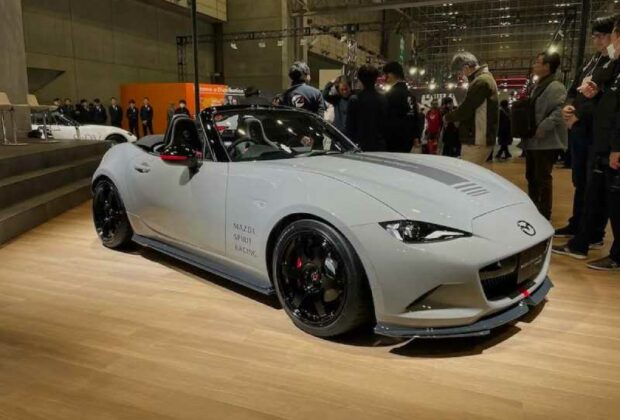The world’s best-selling roadster is Mazda’s erratic MX-5 Miata, which debuted in 1989. The coupe, which is currently in its fourth generation, has undergone multiple revisions and limited editions during the previous thirty-five years. Over a dozen countries host Miata one-make events, a testament to its popularity among racing enthusiasts.
The Hiroshima-based automaker is currently going all out with the Miata and the Mazda 3, two of its best-selling models. Mazda made news once more at the 2024 Tokyo Auto Salon in January when it unveiled two new track-focused cars, the Spirit Racing 3 and the Miata-based Spirit Racing RS. The new sub-brand is called Mazda Spirit Racing.
A brand like this hasn’t existed since the heyday of Mazdaspeed performance and customisation, which reached its zenith in 1991 when the 787B race car won the 24-Hours of Le Mans.
Using technology from the Super Taikyu (Endurance) Series, Spirit Racing aims to launch track-focused cars with enhanced aerodynamics, bodywork, suspension, and brakes. We can anticipate racy body and paint work as well as inventive handling because Mazda has put its former design director and weekend racer, Ikuo Maeda, in charge of this new customising business.
The Miata has a broad Gunmetal Grey pinstripe running from the front of the hood to the rear of the trunk, and it has been painted in a Nardo Grey tone to get things started.
Just below the front wheel arches, the side of the vehicle is adorned with Mazda Spirit Racing decals. Behind the six-spoke Ray’s alloy wheels and Bridgestone Potenza tyres, brilliant red Brembo brake callipers are mounted. Not to mention the side skirts with their single-tunnel exhaust and subdued red accent strips, the dynamic front and rear splitter package on the bumpers is also something we cannot overlook. As Mazda, in our opinion, produces the most attractive automobiles in Japan, we didn’t anticipate anything less in the aesthetics category.
Although Mazda executives would not comment on the new models’ horsepower, they anticipate that the modified Miata would have the same 2.0-liter, 4-cylinder, 181-horsepower engine as the current model, but with a few additional tweaks.
Recaro bucket seats, red stitching, racing parachutes, an Alcantara-wrapped steering wheel with a unique 12 o’clock mark, and racing harnesses are among the aesthetic changes made to the hardcore Miata’s interior.
It seems that Mazda Spirit Racing is becoming into a modern-day reimagining of Mazdaspeed, and we believe this is a positive development. With the CX-5 and MX-30 leading the way, these two aggressively styled versions may be a welcome return to attractive sports cars for a company that has spent the last ten years concentrating on SUVs and crossovers.
Though it’s unclear exactly when these high-performance components will be available in the United States, Mazda has indicated interest in providing these Mazda Spirit Racing alternatives abroad.








